15.1Fare Structure Options
Whatever affects one directly, affects all indirectly. I can never be what I ought to be until you are what you ought to be. This is the interrelated structure of reality.Martin Luther King Jr., civil rights leader, 1929–1968
15.1.1Objectives of Establishing a Fare Structure
The fare structure will, in a large manner, define the income of the system. Careful consideration must be taken when defining the fare structure in order to have a cost-efficient system that takes into account the purchasing capacity of the users. Fare structures can be used as mechanisms of income distribution and should be used by local governments as part of their tools to reach development goals.
Depending on sources of finance, the fare structure may serve the objective of either making the system financially viable or even profitable.
15.1.2Cost Recovery and Profitability
As with any project, costs to be incurred can be divided into two: Capital Expenditures (Capex) and Operational Expenditures (Opex). Capex will be all investments on equipment or infrastructure that will create future benefits. These include all infrastructure investments, vehicle purchases, fare collection equipment, control centers, etc. Opex, on the other hand will be the ongoing expenses the system incurs due to its regular operation. These include all personnel costs, utility bills, petrol, maintenance, financial costs, etc.
The BRT system will have, as other projects, several sources of income to cover Capex and Opex. The most evident one is the customer fare (when not considering free systems). Others may include publicity on stations, vehicles, or on the fare collection medium, cross-subsidies from other transport mediums (car usage, parking, and petrol taxes), and government subsidies, among others. The BRT authority has a responsibility of balancing the expenditures versus the income that the system generates based on the objectives that the system has. If no public funds will be used, the other sources of income generated by the system must be sufficient to cover both Capex and Opex.
Having a profitable system may entail certain benefits: the system is able to provide a higher quality system (technologically and infrastructure-wise), be less prone to political swings, benefit vulnerable populations, and be less of a burden to taxpayers.
If the only source of revenue for the system, however, is the customer fare, the political viability of charging all costs to it may not be an option. BRT authorities have to balance both the technical and political aspects to reach a truly “fair fare” for their BRT system.
Developing countries should try to target fare structures that cover most, or all, of the system’s expenses, due to the lower availability of government funding. This may be politically difficult, however, because it would put the entire system’s cost burden on the customer fare.
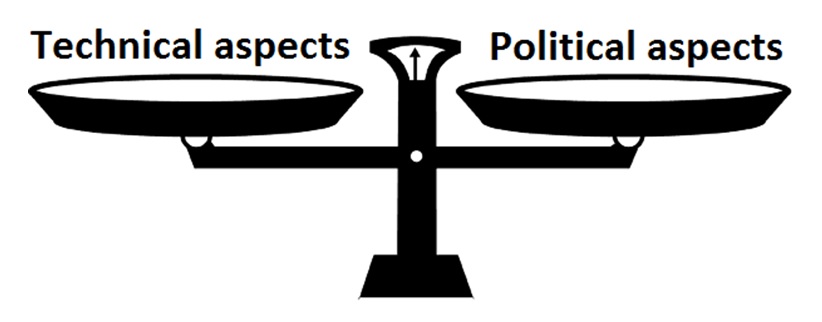
15.1.3Fare Types
The fare type must be decided taking into account the objectives of the local government and access to funding. Several options exist and, as explained before, can serve purposes such as making the system financially viable (even profitable) or as an income distribution tool.
Open Fare (Free Fare)
As the name implies, free fare systems involve charging nothing for public transport use. Some public transport systems in Belgium have realized that their fare collection process is so costly that it makes sense just to provide a free service. By eliminating the fare charges for public transport, there is no need for fare collection and fare verification equipment, no staffing requirements for fare operations, no smart cards or other payment mediums, and no customer wait times for fare purchases.
Further, the design of vehicle interiors and stations is void of the requirements from the fare system. For the vehicle interiors, there is much more space for seating. The implications for station design mean that an open rather than closed design can be utilized. An open design means that there is less visual and physical severance from the station (Figure 15.2). These types of stations are also less costly to construct.
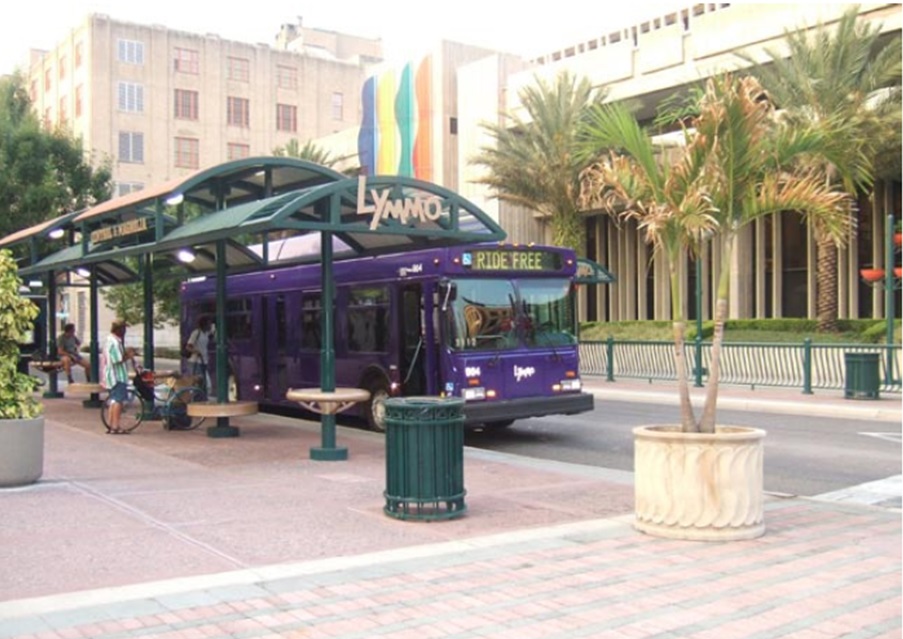
Of course, the main benefit from fare-free systems is the impact on customer numbers. In Hasselt, Belgium, bus patronage jumped from 23,000 customers per month to 300,000 customers per month with the introduction of fare-free service. About 25 percent of private vehicle users have switched to public transport since the implementation of this scheme. Likewise, urban rail fares have also been eliminated in certain areas of Belgium. An added benefit of free fares can derive from considering that, if occupancy rises, it will do so by shifting away from other modes of transport, mainly the use of private cars. This may entail positive externalities such as CO2 emission reductions, fewer car crashes, and reduction in public transport times, among others.
The basis of the decision in Belgium was the fact that approximately 60 percent of the system’s revenues were being used to print, distribute, and inspect fares. If other externality costs, such as impacts on station design and customer wait times, are considered, then the case for fare-free travel will be even stronger.
Fare-free systems have become increasingly common in both Europe and North America. In the United States, cities such as Denver, Miami, and Orlando have some services that operate fare free.
The development of a fare-free system does not mean that the overall business structure must radically change. Private operators can still bid competitively for providing the services. Payment to the operators can still be based on the number of kilometers travelled. The only change is the origin of the revenue stream, which instead of being from the customers will be from other sources, such as road pricing, gas taxes, and parking fees. For example, Orlando pays for its LYMMO service entirely through a parking fee.
In the case of lower-income economies, there is likely to be less of a case for a free-fare system, principally because the cost of fare collection will likely be less. With lower labor costs, there will be fewer instances in lower-income economies where the costs of fare collection begin to approach the revenues gained, thus justifying the elimination of fares.
However, there are examples of cities such as Bogotá utilizing free-fare structures for feeder services. Since feeder services will typically operate with open rather than closed station environments, any fare collection will likely have to occur onboard the vehicles. This arrangement implies that fare readers are required at the doorways. An exit reader may also be required if the transition from the feeder service to the trunk service passes through an open area. All this onboard fare equipment means that the vehicle costs are considerably higher. Additionally, onboard fare collection and verification may also imply a required intervention from the driver (such as providing change) that will slow dwell times and overall travel times. For all these reasons, free-fare systems have a fairly wide applicability to feeder services in both higher-income and lower-income economies.
The main arguments against free-fare systems relate to financial viability, security, and economic principle. First, for many lower-income economies, the ability to secure system financing from other sources besides fares may be limited. In most cases, though, the growth in private motorized vehicles does provide significant scope for using some form of vehicle fees as a revenue source, even though this may be politically hard to accomplish.
Second, some argue against free fares on the economic principle that free goods always lead to market inefficiencies. If a product is not priced, it simply will not be valued by the public, thus the public transport system will be seen as an inferior good. Again, though, one could extend this argument to many other aspects of public space such as footpaths, public parks, and even city streets. Few people would suggest charging pedestrians for using a footpath or families for using a park. In the same way, public transport could also be viewed as an essential public good that should not be burdened by a fee.
Flat Fare vs. Distance-Based Fare
Many cities often debate whether to apply a flat fare or a distance-based fare. A flat fare means that a single price applies to any trip within the system. By contrast, a distance-based fare means that the fare level varies by the number of kilometers travelled.
Each of these options involves a different set of trade-offs. Flat fares can be equitable if low-income groups tend to take long trips and reside at the urban fringe. These peri-urban areas offer property at substantially lower costs than central areas. The long distances between the peri-urban communities and employment opportunities in the city can inhibit access to jobs, health care, and education. If a distance-based fare were implemented in such a situation, the poor at the urban fringe would end up paying the highest transport costs. In order to achieve greater social equity, a flat fare helps to give such low-income groups access to services and opportunities in the city center. In such instances, a flat fare acts as a cross-subsidy from higher-income residents in the central parts of the city to lower-income residents located in peri-urban areas. One of the principal reasons that Bogotá instituted a flat fare was to promote a greater sense of social equity within its public transport system. As TransMilenio’s system has expanded, however, the average trip distance within the system is increasing, as is the cost of providing each trip. This trend is putting upward pressure on the base fare.
A flat fare also permits the use of simpler fare collection technologies. Ticketless options, such as coin-based machines (please refer to Chapter 18: Fare Systems), are possible with a flat fare. Further, a flat fare implies that no distance-verification step is required upon exiting the system. The lack of this verification step reduces queues and thus improves overall system efficiency. In general, a flat fare scheme reduces the level of complexity in fare collection by an order of magnitude.
Distance-based fare systems are utilized quite frequently in higher-income economies, as well as in some rail systems in lower-income economies, such as the SkyTrain in Bangkok, and the Metro in Delhi. Distance-based fare structures most closely mirror actual operating costs, thereby providing a truer measure of expenses for system operators. A longer journey implies that more fuel and labor is required. Thus, distance-based systems do not involve the implied cross-subsidy that exists in flat fare systems.
A distance-based fare will likely get the planned system closer to full cost recovery than a flat fare. So long as the fare revenue is higher than the cost of operating the system, the fare can also vary based on trip distance. More complex fare structures offer the possibility of optimizing the profitability and equity of the system.
The principal disadvantage of complex fare systems, such as distance-based fares, is that these can lead to customer confusion over the actual cost of a given trip. In order to indicate the system fare structure, typically a complex matrix of fares must be posted at the stations. Customers may enter the system without knowing exactly how much their trip will cost. In turn, the result may be that a customer arrives at a destination without sufficient funds on their fare card. This situation may imply the need for a fare adjustment machine at the exit area. It may also imply that customers may be liable for penalties and fines, which will stir customer anger and/or embarrassment. Such incidents can be quite effective in discouraging future use of the system. In Washington D.C., for example, the fare table for the Metrorail can be quite overwhelming for non-regular users, and it requires some knowledge of the city and the system, which is not very likely of tourists (see Figure 15.3).
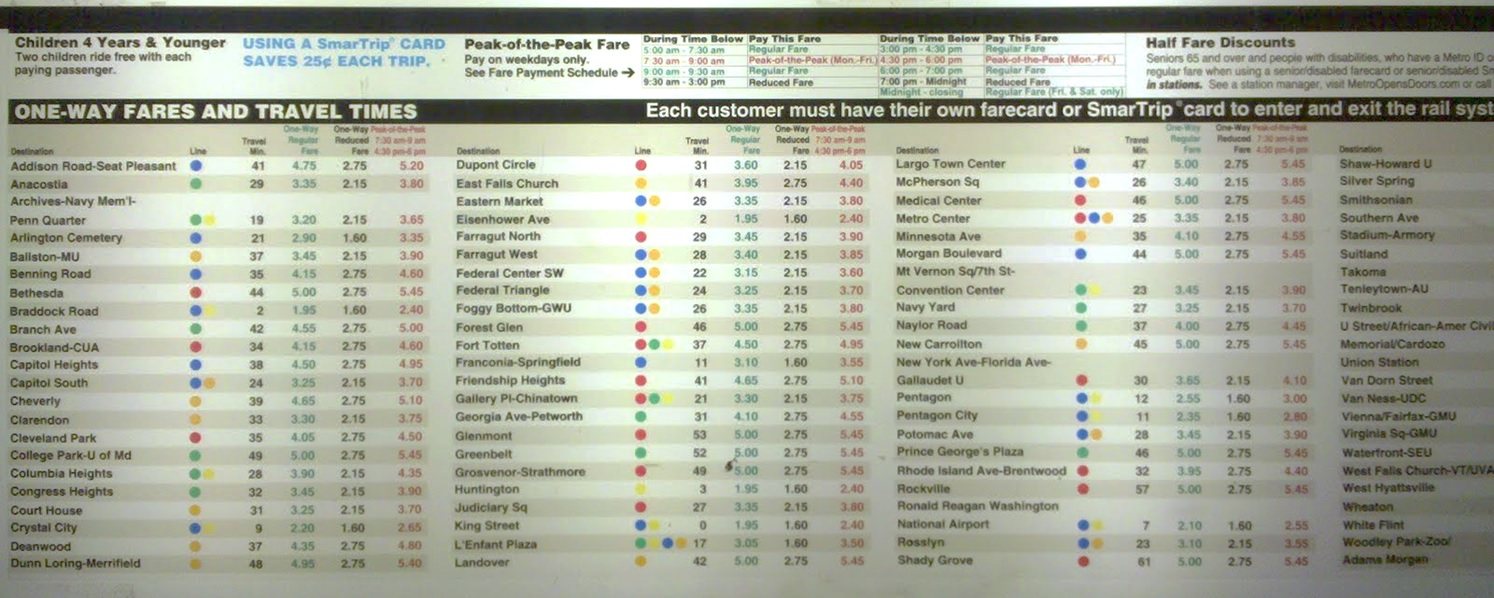
The complexity also means that more things can go wrong with the system, adding to maintenance costs and potential system shutdowns. In the case of cities such as Jakarta, the complexity of the fare system meant that it did not work properly during its first year of operation.
It is also possible to have a mix of both flat fares and distance-based fares. The base fare can be set quite high, and the additional distance–based fee can be set quite low relative to the overall fare price. Alternatively, a flat fare may be utilized within a well-defined urban area while journeys extending to regional locations, such as other municipalities, can require an additional charge. A mixed fare system can be appropriate when a metropolitan area includes satellite commuter cities. If such cities are predominantly middle- or higher-income in nature, then the justification for cross-subsidies is less. For example, the busways in São Paulo charge a flat fare in central areas but revert to a distance-based scheme for continuing on to satellite destinations.
Before deciding on a flat fare, it is worth testing the impact of different fare structures on total system profits. Different fare structures can have widely different impacts on ridership under different conditions.
For example, on the first corridor of the TransJakarta system there are a lot of customers going very short distances, as it is a major shopping area, and people are going from shop to shop. TransJakarta, which adopted a flat fare system, loses a lot of customers because there are minibuses that offer a competing service at a price below the fare for TransJakarta. For short distance trips, customers tend to use the minibuses, but for longer trips where the time savings becomes a major issue, customers tend to use TransJakarta. These short trips on the corridor, however, are generally a highly profitable sort of trip to serve.
On the other hand, on Corridors 2 and 3, most customers were making a very long trip from the periphery to the city center. On these corridors, the flat fare structure gives TransJakarta a competitive advantage over other commercial operators who charged a zone-based fare. This flat fare also attracted a lot of ridership from low-income residents who live at the city’s periphery and who are highly price sensitive.
Therefore, TransJakarta wished to test the impact of a distance-based fare on profit. Table 15.1 shows the results of this analysis. These results clearly show that shifting to a fare structure with a reasonably high minimum fare combined with a distance-based fare would yield substantially more profit than a flat fare system. Figure 15.4 highlights the amount of ridership that each of the different fare strategies would generate.
Table 15.1Comparing Different Fare Structures on Transjakarta
| Option | Base fare (Rp) | Variable portion of fare (Rp/km) | Demand (paying customer) | Collected fare (US$) | Average distance (km) | Operating cost (US$) | Profit (US$) | Max. peak frequency (buses/h) |
|---|---|---|---|---|---|---|---|---|
| Flat fare | Rp 2,500 | 0 Rp/km | 11,523 | $3,201 | 13.47 km | $1,973 | $1,228 | 40 |
| Variable fare 1 | Rp 1,500 | 70 Rp/km | 13,653 | $3,283 | 9.87 km | $1,927 | $1,356 | 46 |
| Variable fare 2 | Rp 1,000 | 110 Rp/km | 16,374 | $3,719 | 7.94 km | $2,054 | $1,666 | 53 |
| Variable fare 3 | Rp 1,500 | 50 Rp/km | 18,270 | $4,129 | 10.68 km | $2,521 | $1,607 | 62 |
Doing this analysis requires a public transport model with an OD matrix of public transport trips. If average public transport trip distances along the planned BRT corridor can be closely estimated, then the technical fare can be recalculated using a distance-based fare.
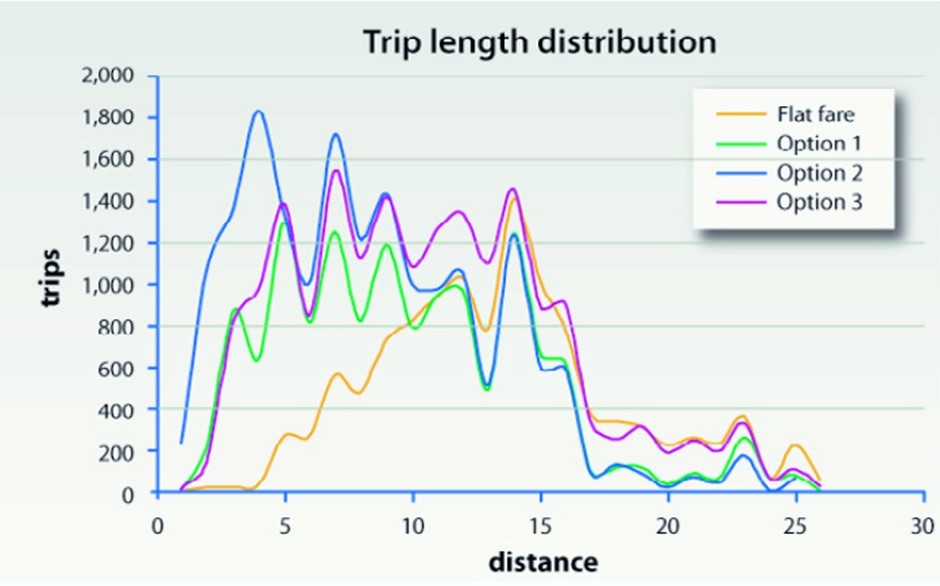
Zonal Fare
Zonal fares are sometimes touted as a simplified version of a distance-based fare. In the case of a zonal fare, customers are charged by the number of zones that are crossed. Thus, if a customer travels from one city district to another, he or she is charged more than someone who only travels within a single district.
The principal advantage of a zonal system is its simplicity, both in terms of reducing customer confusion over fares, as well as in terms of the fare technology required. It is easier to understand the cost implications of travelling in a city with a few zones as opposed to a significant number of permutations related to distance-base combinations.
The principal disadvantage of a zonal system relates to peculiarities in the fare structure, where very short trips between zones can cost double a long trip inside a zone. This type of situation leads to an inequitable application of fare policy and can lead to anger among customers. This very scenario has occurred in Santiago, Chile, and has resulted in some dissatisfaction with the system. As with distance-based systems, this can lead to social inequities if lower-income citizens live on the outskirts of the city and need to travel downtown for work, and hence will need to pay a higher fare. To a certain extent, the advent of the smart card has made the zonal system unnecessary.
Time-Based Fare
While fares can vary by distance, they can also vary by time. The most typical form of time-based pricing is to have a peak-period fare and an off-peak fare. Charging more for peak periods tends to be more profitable in part because roads are most congested during peak hours, creating the strongest incentive to use a BRT system then. Peak-hour customers are also mostly commuters, who have the least flexibility in their travel schedule. Being less flexible means they are less price sensitive, and will pay more to make the trip.
Public transport services that are heavily used during peak hours also have higher operating costs than services with demand that is more smoothly distributed throughout the day. The higher costs occur mainly because more vehicles are needed to service the peak period and because of the impact on labor needs. Bus drivers and other system operators tend to want to work an eight-hour day, whereas the morning and evening peaks will require extra labor. The less peaked the demand, the fewer the number of additional workers that are required to cover the peak periods. A fare system that encourages people to travel during nonpeak periods will help better distribute demand in a way that is more operationally efficient.
Santiago has defined a 20 percent discount during nonpeak hours, so transport users prefer to ride during nonpeak hours, reducing system congestion and improving the efficiency of the fleet. TransJakarta also offered a discount for early morning customers; before 7:30 in the morning, the fare was reduced from Rp 2,500 to Rp 1,500. This type of pricing acts to help spread the peak. Additionally, the lower price served social equity purposes, since early morning riders tend to be from the lowest income groups. Special attention needs to be paid since cross-subsidies may end up coming from lower-income populations because they generally have less flexible travel schedules, and will most likely end up travelling during the peak time.
Other systems use a time-based fare where the fare card buys the right to use the system for a maximum amount of time. This type of fare has much application when it is desirable to provide transfers in systems without physical integration between stations. Thus, transfers between rail services, trunk BRT services, and feeder BRT services can take place without the need for physically closed transfer environments. This is discussed further in the following section.
The advantage to a time-based system is the savings provided to certain customers, especially those travelling at nonpeak periods or those making linked trips using various modes. A time-based restriction also sometimes is useful to prevent some customers from loitering in the system.
If such a scheme is used, the technology must adjust for incidents when it is not the customer’s fault that the time has been exceeded. For example, if a serious delay occurs in the system due to a breakdown, customers will become irate if they also have to pay more. Also, additional time may be given to senior or handicapped citizens. These adjustments can easily be handled by a smart card–based system (see Chapter 18: Fare Systems).
15.1.4Discounts
Multi-Trip Discounts
One of the main cost advantages that private motor vehicle travel has over public transport is that once the customer has sunk the investment into the procurement of the vehicle, the marginal cost of using the car goes down the more the vehicle is used. This situation creates an incentive to drive more. Public transport fares that force people to pay per trip create the opposite incentive—to use the system as little as possible.
Daily, weekly, and monthly passes, and multi-trip discounts are a good way to create incentives among public transport customers to use the system more. Studies show that such incentives will have a particularly large impact on discretionary travel during nonpeak periods. Multi-trip passes can also have significant benefits in terms of reducing queues at the fare booths and the amount of labor needed to staff ticketing sales.
If such passes will be used, careful consideration needs to be given to the way the contracts with vehicle operating companies are structured, ensuring that financing is secured. In Bogotá, for example, since vehicle operating companies are paid based on kilometers, there is no financial impact on implementing such passes. Conventional vehicle operating companies, however, will be paid with a combination of kilometers and customer numbers, meaning that a time-pass will have a big impact on the finances of the entire system.
Transfer-Discounted Fare for Intermodal Transfers
In many cities today, fare structures between different modes, such as rail and bus services, are not well integrated. However, the increasing sophistication of cash cards and modern fare systems is creating many possibilities for giving special discounts for customers transferring from other public transport systems. Such forms of integration can even take place without necessarily having to integrate these public transport systems from a management perspective. This issue is particularly important in the growing number of cities that are building metro systems on some high demand corridors but are considering BRT on other corridors.
In the past, providing a discount for metro or commuter rail system users on the BRT system required a high level of interagency coordination, and discussions frequently broke down on these grounds. For example, in São Paulo, there were bus services, commuter rail service, and the metro system operated by the State of São Paulo, but another, bigger bus system operated by the Municipality of São Paulo. Fare system integration between these systems remains elusive even today, even though these systems are all currently governed by the same political party.
True fare “integration” between different modes is sometimes confused with fare “compatibility.” Fare integration implies that a customer pays for a multimodal fare that does not incur any penalty for changing from one mode to another. Seoul’s fare system comes quite close to achieving this level of integration. Fare compatibility instead just means the various modes share the same payment medium. With fare compatibility, the customer will pay multiple fares according to the number of systems utilized in the journey. Thus, with fare compatibility the customer gains some convenience with a single fare card, but the customer incurs another full fare cost whenever transferring between systems.
The city of Bogotá, with the implementation of its integrated public transport system, Sistema Integrado de Transporte Público (SITP), plans to enforce a time-based discount fare for intermodal transfers. This means that customers will be able to travel among the different transport modes offered by the city at a discounted fare as exemplified in Equation 15.1.
Eq. 15.1 Bogotá’s SITP transfer discounts example (2011 prices in Colombian Pesos):
\[ \text{BRT} + \text{Conventional Bus} = COP1700 + COP1400 = COP3100 \text{(No transfer discount)} \]
\[ \text{BRT} + \text{Conventional Bus} = COP1700 + COP500 = COP2200 \text{(With transfer discount)} \]
Customers will be able to save COP 900, which is nearly a 30 percent savings. This becomes very useful in a city such as Bogotá, where lower-income citizens tend to live on the outskirts of the city and are more likely to require at least one transfer to reach their destination. This scheme results in a cross-subsidy from customers or, depending on the contract type defined for the bus operators, may need direct subsidies from the local government. Again, this may be used as an income distribution scheme; however, careful consideration must be taken to ensure that the income sources for this type of subsidies are secured.
Perhaps the greatest challenge to fare integration between different public transport modes is not the payment technology but the significant differences in operating costs. Attempting to combine systems with dramatically different per kilometer operational costs raises many equity issues. This incompatibility is especially true when one system requires a significant operating subsidy and another system does not. For example, in Seoul, the underground rail system requires a massive operational subsidy while the bus system operates with no subsidy. In order to equilibrate an integrated fare and business structure, the underground metro operator receives a much higher payment per passenger-kilometer served than the vehicle operators. Such inequities may be acceptable in some cases, but it does raise questions about fairness, especially if two services are of comparable quality but of radically different cost structures.
User Profile Discounts
Providing fare discounts to special groups is a relatively common practice in public transport systems around the world. In some countries, while sometimes socially desirable, the requirement that a BRT authority accept special discount fares creates a difficult challenge for any public transport agency. Controlling fraud in the use of discount passes poses a difficult technical challenge.
The determination of discount eligibility for children and the elderly is typically based on age limits. For example, system managers and operators may decide that children under five years of age and adults over sixty years of age qualify for special discounts. The determination of student eligibility is often predicated on either age limits and/or the possession of valid student identification. Student discounts may be limited to only certain student segments, such as primary, middle, secondary, and university levels of education.
Discounts to children, students, and the elderly are typically given for reasons of social equity (Figure 15.5). Economically, a discount strategy can make sense so long as the discounted fare covers at least the marginal cost of each customer. If fare levels are to be reduced below marginal cost levels, then some sort of subsidy system will need to be put in place. Subsidies can take the form of cross-subsidies between customer user groups or direct subsidies from the government to the operators. In either case, the introduction of subsidies significantly increases financial complexity within the operation of the system, and subsidies also create complications with respect to operator incentives. Thus, if a discounted fare structure is to be utilized, it is usually best for the discounted fares to at least cover marginal costs. Otherwise, the resulting cross-subsidy can effectively render the discount meaningless, while simultaneously increasing the management costs of the system. For example, providing a below marginal cost subsidy to a child may simply mean that the parent must pay more to cover the subsidy. In effect, no social equity is being achieved.
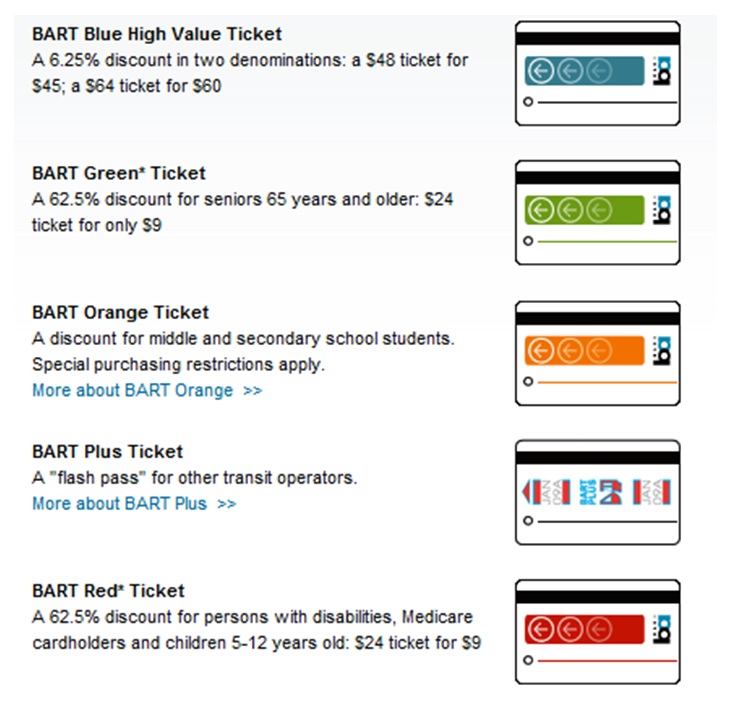
Chile and Brazil, for example, both place a legal obligation on the public transport operators to accept special discounts for students and the elderly. In Brazil, private vehicle operators are not compensated for the provision of this service, and the cost burden related to this service and its fraudulent abuse is a continuing cause of operator claims that they need fare increases. In many instances, operators will simply not stop if they see many students at a stop.
If the BRT system does not have a reliable mechanism to track the number of trips made using such discount passes, it has no way to place a valid claim to the government for compensation. This situation has created an ongoing justification for requiring government subsidies, but no clear basis on which to determine an appropriate level. The subsidies are thus a source of ongoing tension between the government and the operators.
On the other hand, Brazil has another subsidized fare that goes to employed workers called “Vale Transporte.” Vale Transporte is a public transport voucher that is as good as cash to any vehicle operator. Recently the Vale Transporte voucher system has been extended and can even be used with some formerly informal sector minivan services. As this increases demand for public transport services and does not adversely affect bus system profits, it is generally supported in the public transport community. Critics of the program are unhappy about the fact that it targets middle-income people with jobs rather than the very poor, and it costs the government a lot of money to administer, but these are not problems from the point of view of public transport operations. Voucher systems are therefore the preferred route for subsidizing categorical discounts.
Discounted fare systems are also highly susceptible to fraud. As noted above, the qualifications for a child, student, or elderly discount are based upon age or a special identification. However, once the discount passes are issued, it is extremely difficult to ascertain exactly who is using the pass. The discount passes can be “lent” to family or friends who otherwise do not qualify for the discount. More worrying is the development of a gray market for discount passes in which persons obtain passes and sell them to others. Likewise, certain types of monthly passes for frequent users can be abused. If the monthly pass allows unlimited travel on the system, then the pass may end up being shared among several persons.
There are mechanisms to combat fare fraud to an extent. First, the avoidance of discount passes that allow unlimited travel is one option. Instead, discount fare passes that deduct credits for each trip undertaken can somewhat help avoid shared passes. Or, a discount pass could limit its use to no more than two trips per day (i.e., the number of trips in a typical commute).
Second, formal registration and photo identification on the discount card can be the basis for a verification process. The verification could be conducted randomly when customers are inside the system. Also, when a discount card is read at the turnstile area, an indicator light could alert the platform staff. A random verification of such persons could help to stem fraud.
An exception to these recommendations is travel for very young children as designated by a certain age. Requiring a travel pass for a very young child is problematic since it can create a burden on parents. Further, small children who sit in the lap of a parent are not necessarily adding significantly to the operational cost of the system, although certainly space for any strollers can more than compensate. Also, given that the appearance of young children changes considerably in the earliest years, photo passes are not particularly useful. Undoubtedly, some parents will insist that their six- or seven-year-old is only five, but the scope of this sort of deception is usually not significant enough to warrant a stringent approach.
In summary, fare discounts are well-meaning attempts to increase affordability and social equity within a public transport system. In some cases, though, the added costs and complexity of implementing a fare discount strategy can negate these intended benefits. Before committing to a fare discount system, cities should carefully consider the full ramifications.
15.1.5Other Sources of Income
Fares for Feeder Operation
The fare handling system for feeder services will often follow a different operational process than the fare system for trunk lines. As noted earlier, cities such as Bogotá and Quito now compensate feeder operators by a combination of the vehicle kilometers travelled and the number of customers carried. This compensation package attempts to balance incentives in order to motivate operators to provide high-quality service.
Within this model, feeder operations have a range of options for fare collection and fare verification. In Bogotá, feeder operators do not collect the fares from customers boarding at feeder stations. Instead, customers only pay once they reach the terminal stations or intermediate transfer stations. For the return trip home, customers pay upon entering the trunk-line corridor and then transfer for free to the feeder services. However, for the return trip, entry into the feeder service is restricted to those persons who have previously marked their card upon leaving the station. This system holds the advantage of not making the feeder operators handle any revenues from customers. By avoiding fare collection and fare verification at the feeder level, there is considerable time savings, as well as the avoidance of any corruption.
However, the system has the disadvantage of allowing customers to travel from one feeder stop to another feeder stop without paying anything. This situation occurs because payment is only made once customers reach a terminal. In some ways, the “free ride” between feeder stops could be viewed as a positive marketing point for TransMilenio, since people will enjoy having a free neighborhood service. However, the number of persons taking advantage of this free service is now reaching 15 percent of total feeder ridership. TransMilenio has changed feeder operator contracts from being based exclusively on kilometers travelled to being a combination of kilometers travelled and customers carried. It is possible that the addition of customers carried to the contract will provide an incentive for operators to curb the free use of the feeder services.
There are other options for feeder fare control that can avoid some of the issues faced by TransMilenio. Another option is for feeder services to collect fares when customers board the feeder vehicle. While it would likely not be practical to make the driver handle fare collection and/or fare verification, the addition of fare collection staff to the vehicle could be a solution. Boarding the vehicle could take place at a single doorway (e.g., the rear door). Likewise, alighting the vehicle would then only be allowed at the other doorway (e.g., the front door).
The fare collection staff (i.e., conductor) could be from the fare collection company and not from the feeder operating company. This separation of interests would help to avoid any mishandling of fare revenues. Customers boarding the feeder vehicle would enter a closed reservoir area in the bus, and then proceed through a turnstile once payment to the fare collection staff is made. The reservoir concept allows the vehicle to continue to the next stop while customers are being processed through fare collection. The reservoir concept is already utilized extensively in Brazil for conventional bus services. The disadvantage of this option is the cost of adding another staff person to the vehicle and the cost of the fare collection infrastructure within the vehicle. However, in many developing cities, the lower labor costs, in conjunction with political needs to maximize employment, make this option a viable possibility. Further, if the free ridership problem experienced in Bogotá was of such a magnitude, then the additional fare collection staff could be fully cost justified.
If the feeder customer volumes are sufficiently high, then other options utilizing more sophisticated fare technologies may be possible. These options include:
- Fare collection vending machines at feeder stations (either open or closed stations);
- Smart card readers upon entering a closed feeder station;
- Smart card readers upon entering the feeder vehicle.
Cities such as London are utilizing coin-fed fare collection machines at conventional open bus stations (see Chapter 18: Fare Systems). This type of technology could be adaptable to feeder services in some developing cities. If the station was closed (i.e., no entrance without fare payment), then a coin-based or even smart-card-based system could permit entrance to the station. Alternatively, a fare card purchased at a vending machine in an “open” station could then be verified inside the vehicle. The verification could either be done in a closed reservoir environment on the bus or by way of an honor system, where customers self-validate their fare tickets. If smart cards are utilized, then again, the fare verification could take place through a self-validating machine inside the vehicle.
All of these technological solutions, though, do have limitations in the developing city context. First, the cost of the technologies for feeder services may be prohibitive from both a capital and operating cost standpoint. Second, creating “closed” stations at feeder stops may not be practicable from either a spatial or a cost perspective. Third, the effectiveness of “honor” payment and verification systems in developing cities is still not proven. Fourth, costly fare collection machines left unprotected at feeder stations could be subject to maintenance issues and even theft.
Publicity
Publicity can be used as a means of generating additional income for the system. The BRT infrastructure, including stations, vehicles, and fare collection medium can all be used. Furthermore, the system can be used to communicate important messages from the local government or as means of art galleries to enhance the user experience (Figure 15.6 and Figure 15.7).
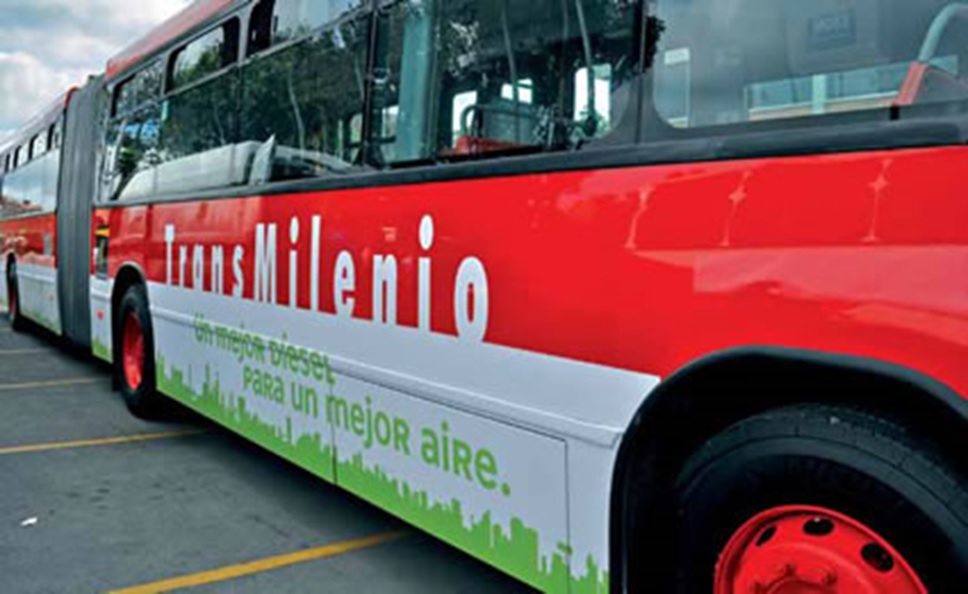
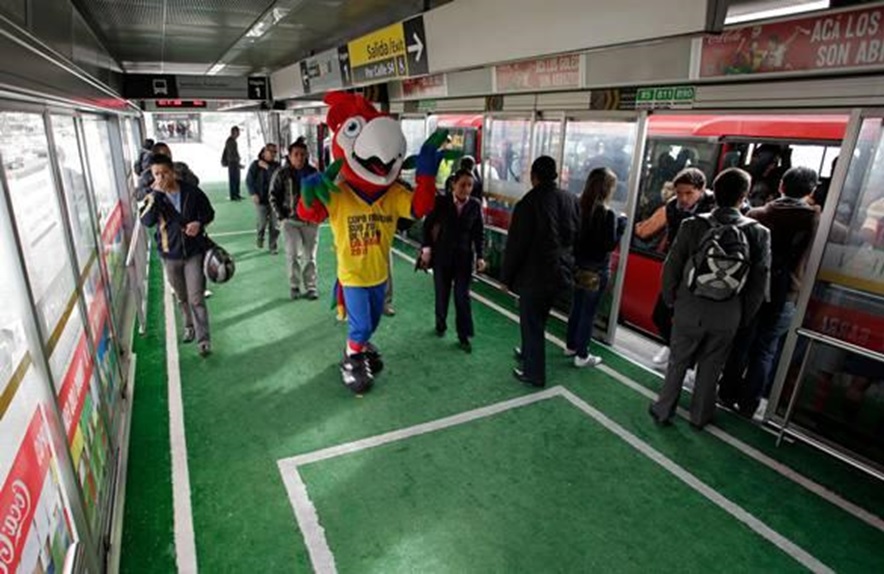
All contracts between the different actors need to consider where the profits from publicity will go. In Bogotá, for example, publicity in vehicles belongs to the vehicle operating company.
Government and Cross-Subsidies
As described in the previous chapters, there are several instances where subsidies can be implemented in the system, whether directly to the fare or to user groups, for long distance travel and others.
Decision makers need to be very careful about which strategy to use when implementing subsidies. Special care needs to be taken with the sources of income to be used. Subsidies that come from the fare may have negative results, since this will mean that the entire population is paying for something that will only benefit public transport customers. When implementing cross-subsidies for income distribution purposes, the “giver” and the “receiver” must be clearly identified.
The preferred sources of income for subsidies should then be from other less beneficial modes of transport to the city (that produce large negative externalities), such as private cars. These subsidies would be in the form of congestion charging and pollution taxes, among others. If subsidies are given to the operation of the system, they should be given as a constant and guaranteed income flow that is supported by technical analysis, as opposed to being given based on only political grounds, which would generate a hole in the city’s future finances.
Other forms of subsidies can be given to the Capex of the system. By building infrastructure and charging the vehicle operators for the right of use of this infrastructure, the local government will be subsidizing the operation of a BRT system without the need to have a constant income flow. Again, the contractual obligations of the vehicle operators must be considered carefully in order not to subsidize the companies themselves in detriment of the end users.
Multilateral Organizations
Multilateral organizations can often provide good credit access and conditions for public projects. These can be taken generally by the city itself, or sometimes are available to the private sector, with the city as collateral. This is a good way of financing the infrastructure of the BRT system at a lower cost than what the financial market offers.